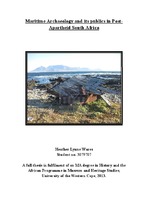| dc.description.abstract | Since the end of apartheid and with that the construction of a new South Africa,
archaeology has experienced what can be seen as a resurgence in the public domain. With the creation of a new nation imagined as existing since time immemorial, there has been an emergence of archaeological pasts providing evidence of a nation believed to have existed before apartheid and colonialism. Due to this resurgence of interest in the pre-apartheid and pre-colonial pasts, there has been a ballooning of research and exhibitions around paleontological finds, rock art sites and Iron Age sites indicative of early state formation. This has transported the nation back into what Tony Bennett has called 'pasts beyond memory'. Where mainstream archaeology focuses on sites which reflect a history outside of a colonial past, maritime archaeology has had difficulty. Being a discipline with its main object of focus being the shipwreck, it is difficult to unravel it from a colonial legacy. In an attempt to move away from these older notions of 'public' through the allure of the shipwreck, some maritime archaeologists have looked at different mechanisms, or what I call 'modes of representation', to construct new South African publics. Two such mechanisms are discussed in this thesis: the temporary exhibition of the Meermin Project, and the Nautical Archaeology Society courses on Robben Island. This is in contrast to the older Bredasdorp Shipwreck Museum, where I argue by using Greenblatt’s notion of 'resonance and wonder', that the wonder of the object salvaged is the central feature of the way it constructs its publics. This thesis discusses how a group of maritime archaeologists, located at Iziko Museums and the South African Heritage Resources Agency, attempted to construct new publics by locating resonance with its subject in an exhibition, and by making new archaeologists through a hands-on course. | en_US |

